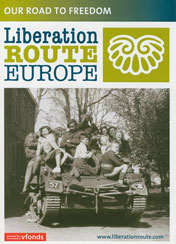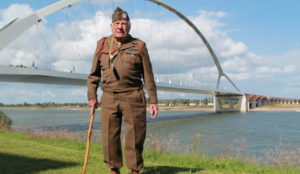 What a joy it was to meet Victoria van Krieken, the vibrant director of the Liberation Route Europe! She’s an enthusiast of the best kind: enterprising, forthright, inventive, dedicated and determined. Over several cups of tea and a delicious salad, we learned about each other’s work. Our meeting was more than timely, since we are only a few days past the date when the Canadians freed the northern Netherlands, and a few days before the anniversary of the Nazi invasion on May 10.
What a joy it was to meet Victoria van Krieken, the vibrant director of the Liberation Route Europe! She’s an enthusiast of the best kind: enterprising, forthright, inventive, dedicated and determined. Over several cups of tea and a delicious salad, we learned about each other’s work. Our meeting was more than timely, since we are only a few days past the date when the Canadians freed the northern Netherlands, and a few days before the anniversary of the Nazi invasion on May 10.

The daughter of a Dutch/Polish couple, van Krieken listened patiently as I told her how the stories of the Nazi occupation of Amsterdam reached out and grabbed me as I did the research for An Address in Amsterdam. I was fascinated to hear how the Liberation Route became a reality through drawing together people across nations, perspectives and even eras. Far from being a relic to be re-visited only by those who have trodden there before, the Route is created not only for nostalgic visits, but to make an ongoing legacy connect with new generations. So many different elements are linked now across national boundaries – sites, trails, museums and activities. Visitors are engaged in a wide variety of ways, from audio spots where people can listen to stories, to more usual historic places and interactive museums.
The 75th anniversary of Liberation in 2019-20 is a unique moment. Van Krieken points out that  it is the last time “we will be able to honor the veterans in their presence.” Even if a few live until the 80th anniversary, there is no guarantee that they will be in a condition to participate. So this is the last opportunity for a certain kind of connection with the past – and to assure the veterans that future generations will continue to walk in their footsteps. Three big projects will support the anniversary effort: a multifaceted commemoration with an emphasis on involving people across countries, occupations and generations; an international awareness campaign; and completion of the Trail itself. How wonderful to imagine what this dynamic woman and her young staff will come up with to bring the past into the future! It is a “modern pilgrimage” as van Krieken puts it. People from every country will be welcome either to participate in person or in electronic ways that we can only begin to conceive of now. In either case, we won’t forget.
it is the last time “we will be able to honor the veterans in their presence.” Even if a few live until the 80th anniversary, there is no guarantee that they will be in a condition to participate. So this is the last opportunity for a certain kind of connection with the past – and to assure the veterans that future generations will continue to walk in their footsteps. Three big projects will support the anniversary effort: a multifaceted commemoration with an emphasis on involving people across countries, occupations and generations; an international awareness campaign; and completion of the Trail itself. How wonderful to imagine what this dynamic woman and her young staff will come up with to bring the past into the future! It is a “modern pilgrimage” as van Krieken puts it. People from every country will be welcome either to participate in person or in electronic ways that we can only begin to conceive of now. In either case, we won’t forget.
